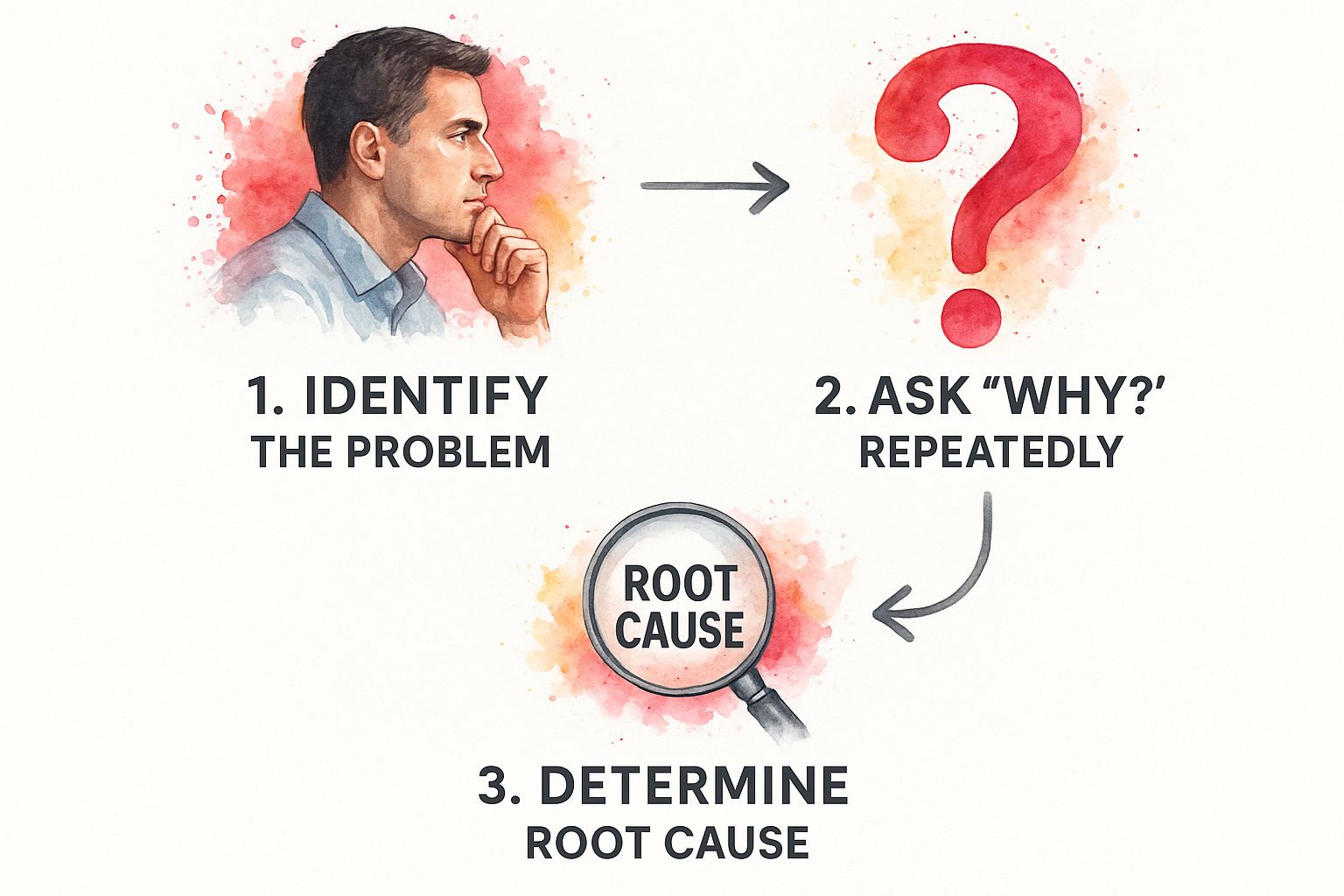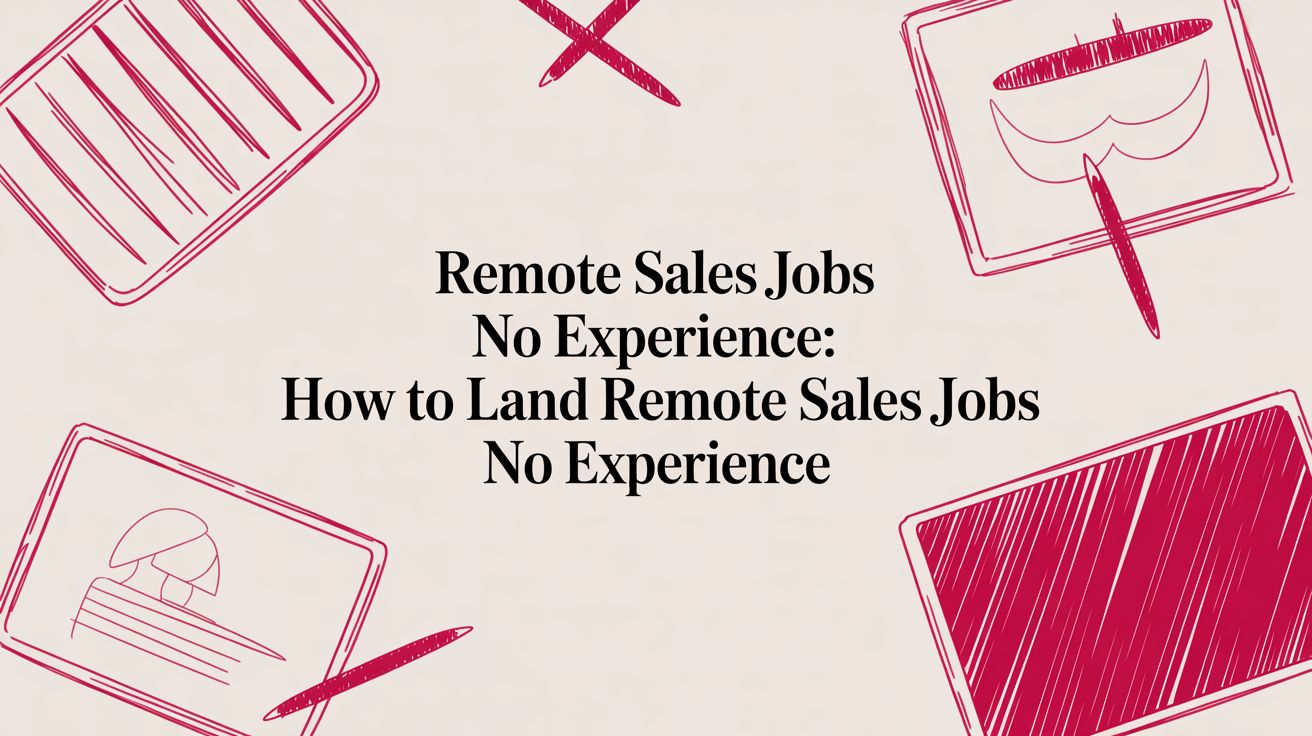Mastering How to Improve Problem Solving Skills
Max
Of all the skills you can develop in your career, I’d argue that problem-solving is the most valuable. It’s your superpower, especially when you’re working remotely.
When you’re a remote professional, you often have to tackle issues on your own, without the instant backup of a team right next to you. It’s the one skill that consistently tops the list of what employers are hunting for, acting as the main driver for career growth and leadership potential.
Why Problem Solving Is Your Most Valuable Skill

The modern workplace has changed. We’ve moved far beyond the days of routine, predictable tasks. Today’s economy is all about rewarding people who can think analytically, approach issues with a creative spark, and navigate ambiguity with confidence. Companies don’t just need people who follow instructions; they need thinkers who can spot a problem, dissect it, and forge a path to a solution.
The Data Behind the Demand
This isn’t just a hunch; the data backs it up completely. The World Economic Forum’s 2025 Future of Jobs Report found that analytical thinking—which is the heart of problem-solving—is still the most valued skill by employers across the globe. A staggering 70% of companies rate it as essential. You can dig into the full details in the WEF’s comprehensive report.
This massive demand translates directly into better career opportunities. The moment you prove you can untangle tough problems, you become an indispensable part of the team.
Developing this skill isn’t just about getting better at your current job. It’s about future-proofing your career against automation and positioning yourself as a leader who can deliver results, no matter the obstacle.
From Buzzword to Bottom Line
Getting better at solving problems delivers real, tangible benefits that go way beyond just looking good on your resume. It gives you the power to:
- Work more efficiently by getting straight to the root cause of an issue instead of just patching up the symptoms.
- Boost your confidence in handling those unexpected setbacks—a daily reality in many remote roles.
- Drive real innovation by looking past the obvious answers to find creative, more effective solutions.
- Build your leadership qualities as you naturally become the go-to person for cracking complex challenges on your team.
Ultimately, learning how to sharpen your problem-solving skills is a direct investment in yourself. It shifts you from being a simple task-doer to a strategic thinker, opening doors to bigger responsibilities and more professional success. Think of it as the foundation on which all your other professional skills are built.
Using a Framework to Solve Problems Systematically
Great problem-solvers aren’t just winging it. They don’t wait for a stroke of genius to hit; instead, they lean on a structured approach to break down even the most intimidating challenges. When you have a framework, a chaotic issue suddenly becomes a manageable process. It gives you a reliable roadmap for any obstacle, whether it’s a minor team hiccup or a major project roadblock.
This is how you move problem-solving from a mysterious art to a repeatable science. A systematic method keeps you from falling into the classic trap of jumping to conclusions or just patching up surface-level symptoms. Instead of feeling overwhelmed, you gain a sense of clarity and control. You can be sure you’re not just busy, but actually effective.
Here’s a look at a straightforward, four-stage framework I’ve seen work wonders for remote teams.
A Four-Stage Problem Solving Framework
| Stage | Objective | Key Actions |
|---|---|---|
| 1. Define | Identify the true, underlying problem. | Ask “why” repeatedly, gather data, and challenge initial assumptions. |
| 2. Ideate | Generate a wide range of potential solutions. | Brainstorm without judgment, use creative techniques, and encourage diverse ideas. |
| 3. Implement | Select the best solution and test it. | Plan a pilot test, set up a small-scale trial, and gather initial performance data. |
| 4. Review | Analyze the outcome and document learnings. | Measure against success metrics, collect feedback, and apply lessons to future problems. |
This table gives you a bird’s-eye view, but the magic is in how you apply each stage. Let’s break it down.
Define The Real Problem
First things first: you have to figure out what you’re actually trying to solve. So many “failed” solutions aren’t bad ideas at all—they’re just perfectly good answers to the wrong question. This stage is all about digging deeper than what’s immediately obvious on the surface.
For instance, maybe your remote team’s productivity has dipped. The easy, surface-level problem is “people are working slower.” But is that really it? The real issue could be anything from unclear project briefs and communication bottlenecks to straight-up burnout from an inefficient workflow.
A powerful technique here is to just keep asking “Why?” until you can’t anymore. This is how you expose the core issue and truly improve your problem-solving skills right from the foundation.
To get a better sense of this, think about peeling back the layers of an onion.

The image drives home a key point: you have to get past the initial problem statement to find a solution that will actually stick.
Ideate A Range Of Solutions
Once you have a crystal-clear definition of the problem, it’s time to get creative and generate potential solutions. The goal here is quantity over quality, at least to start. Don’t censor yourself or your team. Encourage a whole spectrum of ideas, from the dead-simple and practical to the wild and unconventional.
You can use brainstorming techniques like mind mapping to visually connect ideas or try the SCAMPER method (Substitute, Combine, Adapt, Modify, Put to another use, Eliminate, Reverse) to force yourself to look at the problem from different angles. This is the phase where real innovation often sparks to life.
Implement And Test Your Best Idea
With a solid list of potential fixes, you need to pick the most promising one and map out a realistic action plan. A huge part of making any problem-solving framework work is applying strategies for faster decision making so you can move from thinking to doing without getting stuck.
But you don’t have to go all-in right away. Instead of committing to a full-scale, irreversible launch, think about running a pilot test. If the problem is a nasty bug in a software build, you might deploy a patch to a small group of internal users first.
This is a common approach when hiring, too. Many companies looking for the best ways for hiring remote software developers will use a paid technical challenge to test a candidate’s skills on a small, controlled problem before extending a full-time offer.
A small-scale test minimizes risk. It allows you to gather real-world data on whether your solution works as intended without disrupting the entire system if it fails.
Review The Outcome And Learn
The final, and arguably most important, stage is to review the results. Did your solution actually solve the problem? What were the unintended side effects? This step is all about measurement and learning.
- Define Success Metrics: Before you even start, decide what success looks like. Is it a reduction in customer support tickets, an increase in team velocity, or better employee feedback scores?
- Gather Feedback: Go out and actively seek input from everyone who was affected by the change. Their perspective is invaluable.
- Document Lessons: Whether the solution was a smashing success or a total dud, write down what you learned.
This feedback loop is what makes the framework so powerful. Every single problem you solve, regardless of the outcome, sharpens your skills and makes you better prepared for the next one. It’s a true cycle of continuous improvement.
Building Your Analytical and Critical Thinking

Let’s be honest: sharp analytical and critical thinking skills are what separate good problem-solvers from great ones. These aren’t just buzzwords for a resume; they’re the mental muscles you use every day. The more you train them, the stronger and more reliable they become when a tough challenge lands on your plate.
Building these skills means you stop taking information at face value. Instead, you learn to peel back the layers of a complex issue, breaking it down into smaller, more manageable pieces. This is a core technique that top engineers, project managers, and strategists use to transform an overwhelming problem into a series of solvable puzzles.
Deconstruct Problems Like An Engineer
A big, messy problem can feel impossible to even start. The trick is to break it down.
Imagine you’re a remote team lead and you’ve noticed a dip in team productivity. The gut reaction might be, “We need to work harder.” But an analytical approach forces you to ask better questions:
- Clarity: Are our project briefs crystal clear, or are people constantly waiting on information from others?
- Workload: Is the work spread evenly, or are a few key people completely overloaded?
- Friction: Is our project management software causing headaches? Are technical glitches slowing us down?
- Vibe: How is the team actually feeling? Is burnout or disconnection creeping in?
By isolating these different factors, the problem suddenly has a shape. You’re no longer fighting some vague monster; you’re tackling specific, fixable issues. This decomposition is a game-changer for your problem-solving abilities.
A huge part of this process is figuring out what to tackle first. Using tools like a priority matrix can be incredibly helpful for sorting through your options and focusing your energy where it’ll make the most impact. You can find excellent guides and templates for priority matrix tools to get started.
Challenge Assumptions With First Principles
One of the most powerful mental models you can adopt is First Principles Thinking. This isn’t as complicated as it sounds. It just means you break a problem down to its most basic, fundamental truths—the things you know for sure—and build your solution up from there.
For instance, a common assumption on a remote team might be, “We need more meetings to improve collaboration.” First Principles thinking challenges this head-on.
What’s our real goal here? Effective collaboration. Okay, what’s a meeting? It’s just one method for communication. Are there other, maybe even better, ways to get there? Think asynchronous updates, detailed shared documents, or dedicated Slack channels for specific topics.
This kind of thinking forces you to question your own habits and baked-in beliefs. It stops you from slapping old fixes onto new problems just because “that’s how we’ve always done it.”
In a remote environment where clarity and trust are everything, this level of critical thought is non-negotiable. If you want to dive deeper into this, check out our guide on building trust in virtual teams.
When you consistently practice breaking down problems and challenging your assumptions, you start to build a powerful analytical framework. You’ll spot patterns faster, weigh evidence more effectively, and approach any challenge with a calm, structured mindset. This systematic approach is the bedrock of becoming a truly reliable problem-solver.
Unlocking Creative and Innovative Solutions
While sharp analytical skills help you break a problem down, creativity is what lets you build a truly brilliant solution back up. The best answers rarely come from following the same old playbook. They come from looking at a challenge sideways and stepping outside the lines of conventional thinking.
This is where you can really level up your problem-solving chops—by actively nurturing your innovative side. It means consciously ditching the “this is how we’ve always done it” mentality. Too many of us fall into the trap of forcing old solutions onto new problems, which leads to stagnation and missed opportunities. Real progress happens when you dare to think differently.
Escaping Conventional Thinking
To find those game-changing solutions, you have to actively question your own assumptions. One of the most powerful ways to do this is with Lateral Thinking. It’s all about approaching problems from completely unexpected angles. Instead of walking a straight, logical line from A to B, you deliberately leap to a new starting point.
For instance, a remote team struggling with low engagement might immediately think about scheduling more social video calls. But lateral thinking flips the script. It asks, “What if the solution isn’t adding more, but changing the format entirely?” Suddenly, you’re brainstorming ideas like a shared, asynchronous ‘win of the week’ channel or a collaborative team playlist.
The goal of creative problem-solving isn’t just to find an answer; it’s to find the best answer, which often hides in plain sight, just outside your usual field of vision.
The need for these advanced skills is undeniable. A major skills survey revealed that only 36% of U.S. adults performed at a competent level in digital problem solving. That puts them behind countries like Japan (56%) and Finland (51%). This gap highlights a serious need to cultivate more sophisticated ways of thinking. You can dig into the key findings on adult skills to see the full picture.
Using Frameworks for Creativity
Creativity doesn’t have to be a lightning strike of pure genius; you can actually use structured techniques to coax it out. The SCAMPER method is a fantastic framework for this. It’s a simple acronym that provides seven different lenses for looking at a problem:
- Substitute: What parts of this process or product could we swap out?
- Combine: Can we merge two separate ideas or even departments to create something new?
- Adapt: What could we borrow from a completely different industry or context?
- Modify: How can we change the scale, shape, or feel of our current approach?
- Put to another use: Could this existing solution solve an entirely different problem?
- Eliminate: What would happen if we just removed this feature or step altogether?
- Reverse: What if we did the complete opposite of what’s normally expected?
Imagine your marketing team hits a creative wall with a new campaign. Using SCAMPER, you might Adapt a successful customer loyalty strategy from the hospitality industry and apply it to your software product. It’s this kind of cross-pollination that so often sparks real innovation.
Tapping into diverse perspectives is also a huge piece of the puzzle. A developer might see a simple technical fix for a marketing issue that the marketing team would never have thought of. By staying curious and collaborating openly, you can transform a tough challenge into a major competitive advantage. This mindset is a cornerstone of modern work, which you can learn more about in our guide to remote work best practices.
When you pair analytical rigor with creative exploration, you’ll be equipped to handle just about any problem that comes your way.
Putting Your Skills Into Practice

Theory gives you a map, but practice is where you learn the actual terrain. Problem-solving isn’t a passive skill you can just absorb from an article; it’s an active one you forge in the fire of real-world challenges. Let’s be honest, anyone can follow a script when the stakes are low. The real test is what you do when a genuine, high-pressure situation lands on your plate.
This is where you shift from simply knowing the steps to actually doing them. The goal is to build up your mental agility—that knack for staying calm, structured, and creative, even when things get chaotic. Let’s walk through a few scenarios to start strengthening that muscle.
Case Study One: Resolving Team Conflict
Picture this: two of your best people on a remote team are clearly at odds. The friendly Slack banter has been replaced by clipped, formal messages. Worse, their joint project is now falling behind schedule. The obvious problem is the delay, but the real issue runs much deeper.
Instead of just cracking the whip on the deadline, a structured approach is your best bet.
- Define the Real Problem: The project delay is a symptom. The disease is the breakdown in communication and trust between your team members. Your actual goal is to get their working relationship back on track.
- Brainstorm a Few Fixes: You could hold separate, confidential one-on-ones to get each person’s side of the story. Another option is a facilitated group meeting with clear ground rules for respectful dialogue. You might even temporarily shuffle tasks to give them some space.
- Test a Solution: Starting with one-on-one chats is the lowest-risk move. It lets you gather information without putting anyone on the defensive. Based on what you learn, you can then decide if a mediated call is the right next step.
- Check the Results: After the meetings, keep a close eye on their interactions. Is the communication improving? Are they collaborating more smoothly on the project? The outcome will tell you whether your intervention worked or if you need to try something else.
This kind of situation really drives home how crucial a healthy team environment is. Building a strong remote work culture is your best defense against these conflicts and the key to resolving them when they pop up.
Case Study Two: The Sudden Budget Cut
You’re steering a key project, everything is going smoothly, and then you get the email: your budget has been slashed by 30%, effective immediately. It’s easy to panic, but a systematic approach gives you a clear path forward.
Instead of seeing this as a catastrophe, reframe it as a creative constraint. Your new problem isn’t “we’re doomed,” it’s “how do we deliver the most critical project goals with 70% of our original resources?”
This immediately forces you to deconstruct your project plan. What are the absolute “must-haves” versus the “nice-to-haves”? Can you swap a pricey software subscription for a lower-cost or open-source alternative? It’s about being ruthless with prioritization and hunting for clever efficiencies.
Looking at how major companies tackle huge problems can be incredibly insightful. For example, it’s worth reading about how PayPal efficiently solved a significant challenge with its infrastructure by thinking outside the box.
Daily and Weekly Practice Drills
Great problem-solvers aren’t born; they’re built through consistent practice. You need to build the mental reflexes so that when a crisis hits, you’re already warmed up.
Here are a few simple drills to work into your routine:
- Daily Logic Puzzles: Spend 10-15 minutes a day with a logic puzzle, Sudoku, or even a good crossword. These activities train your brain to spot patterns and think in a structured way.
- Weekly Deconstruction: Take a common challenge—like planning a complicated weekend trip or optimizing your weekly grocery run—and consciously walk it through the Define, Ideate, Implement, and Review steps.
- “Reverse Engineer” a Success: Once a week, pick something that went really well, like a smooth project launch or a great client meeting. Break down exactly why it was successful. Figuring out what creates success is just as valuable as analyzing failures.
Think of these small, consistent exercises as reps and sets for your brain. They make structured thinking feel like second nature, so you’re always ready for the main event.
Have a Question About Problem-Solving? Let’s Tackle It.
As you start getting serious about sharpening your problem-solving skills, a few questions are bound to pop up. It happens to everyone. Let’s walk through some of the most common hurdles, from hitting a mental wall to figuring out if all this effort is actually making a difference.
One of the first things people ask is, “How can I tell if I’m actually getting better at this?” It’s a great question. Unlike learning a new software where you can see your progress, critical thinking doesn’t come with a handy progress bar. My go-to recommendation? Start a “problem journal.”
Seriously, just jot down the challenges you face, what you tried, and how it all turned out. Over a few weeks or months, you’ll start to see a clear pattern. You’ll notice yourself untangling more complex issues, and you’ll be doing it faster and with way more confidence.
Another frequent question is about leadership. How does this all connect to being a good leader? Simple: problem-solving is leadership. Leaders are the ones everyone looks to when things get ambiguous or tough. They’re expected to see a path forward and make a solid call.
You don’t have to wait for a big promotion to start. Begin by taking ownership of smaller issues within your team. Use some of the frameworks we’ve talked about to guide your colleagues toward a solution. It’s a fantastic way to build their trust in you—and their own skills. This is a non-negotiable for anyone looking to grow their career.
What If I’m Just… Completely Stuck?
We’ve all been there. You’re staring at a problem, you’ve tried everything you can think of, and you’ve hit a brick wall. The absolute worst thing you can do is just keep banging your head against it. It’s time to step back.
- Change your scenery. Get up and go for a walk. Move to a different room or a coffee shop. A new physical space can do wonders for creating a new mental perspective.
- Talk it out. Try explaining the problem to a coworker. The act of articulating it out loud often forces you to simplify things and, boom, you suddenly see the gap in your logic. Don’t have a coworker handy? A rubber duck works just fine.
- Sleep on it. It’s not just a saying. Your brain is a powerhouse that keeps processing information even when you’re not consciously thinking about it. So many “aha!” moments have come to me right after a good night’s rest.
This isn’t just about feeling smarter—it has a real-world payoff. Research from the OECD shows that a one-standard-deviation jump in problem-solving ability correlates with 7% higher hourly wages. Despite this, less than 5% of adults ever reach the highest level of proficiency. You can learn more about the importance of adult problem-solving skills directly from the source.
These abilities are especially critical when you’re dealing with common remote work challenges, where you’re often the first and only line of defense for solving an issue. By deliberately practicing and applying these techniques, you’re making a direct, high-return investment in your career.
Ready to find a role where you can put your sharp problem-solving skills to the test? Remote First Jobs connects talented professionals like you with top companies offering genuine remote opportunities. Start your search for the perfect remote job today!


